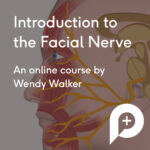These are must do courses for anyone working in primary care, neurology or musculoskeletal settings.
Bell’s palsy usually presents with an isolated facial nerve palsy but if you are unfamiliar with the condition or with the cranial nerves it’s easy to mistake the symptoms for a stroke.
That being said, although rare, a lacunar infarct involving the lower pons can present with isolated facial nerve palsy-like symptoms which is why it’s important to know how to consider differentials when assessing someone with facial palsy.
In these courses you’ll cover all the basics (and more!) you need to know when assessing someone with Bell’s palsy. To take part today follow the links below.
The Tutor – Wendy Walker
Wendy is a neurological physiotherapist, specialising in Facial Palsy, Peripheral Nerve Injuries and Neurology and Complex Conditions.
 Wendy Walker has 38 years of experience in treating neurological and complex conditions such as facial palsy, peripheral nerve injuries, stroke, head injury, vestibular disorders, chronic pain conditions, and incontinence. She has advanced Bobath and paediatric Bobath training as well as extensive training in incontinence and sEMG Biofeedback.
Wendy Walker has 38 years of experience in treating neurological and complex conditions such as facial palsy, peripheral nerve injuries, stroke, head injury, vestibular disorders, chronic pain conditions, and incontinence. She has advanced Bobath and paediatric Bobath training as well as extensive training in incontinence and sEMG Biofeedback.
Wendy regularly lectures and presents courses on sEMGm, fascial palsy, neurological and vestibular rehabilitation to physiotherapists, GPs and surgeons. In 2017-2018 she was the team lead on creating 4 online Physioplus MOOC courses on Physical Activity and she is the Physiopedia topic expert on Facial Palsy.

The Courses
These two courses are definitely ones to add to your to-do list. Wendy has an awesome presentation style and ensures you maximise your learning opportunity. Plus there are more courses coming later!

